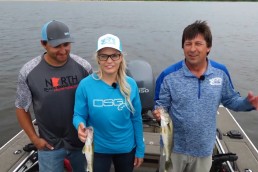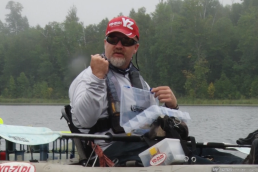Plucking Walleyes Fishing from a Distance in Clear Water
SHARE THIS POST
Early-summer walleye fishing brings visions of fishing in moderate temperatures of 65 to 70 degrees with a light breeze while jigging a lively spottail shiner. Sometimes, that is exactly how it goes! Other times, it’s 80 to 90 degrees in June. Or it’s snowing in early June.
For anglers, it’s a simple adjustment in clothing. For walleyes, it’s all about a hyper-fast biological clock. They spawned less than a month ago. The males continue to eat during the spawn, while most of the females drop down to the nearest breakline and rest. We still see a few bigger female walleyes from the time of the inland fishing opener in early May through Memorial weekend. But in June, the walleye population puts on the feedbag!
Water clarity
Every body of water in Minnesota has different characteristics that set it apart from others. Traditional lakes with 6 to 10 feet of clarity have a great daytime bite for walleyes through most of June. Clear lakes—be they naturally transparent, or unnaturally so due to invasive species such as zebra mussels—often have tough daytime bites, with more walleye action during low-light periods.
Consistent angler harvest draws increased numbers of anglers due to social media and word-of-mouth. Lakes such as Upper Red Lake, Lake of the Woods and Bow String are classic examples of the slam-dunk, limit-out type of walleye fishery. There are many lakes with similar characteristics.
Going, going, gone
Invasive species are affecting lakes like Leech Lake, Bemidji, Mille Lacs, Winnie and Cass. Pulling up on my traditional spots on Leech Lake was a shocker last year; I could see rocks and structures from a distance. Anglers can adapt to these changes in water clarity.
I have heard people talk about how the fish aren’t on the traditional spots they have fished for years. Some anglers leave frustrated, with few walleyes or none at all. They incorrectly assume there are no fish left in the lake. In reality, there are just as many walleyes—or even more, because fewer are being caught.
I have noticed that lakes seem to have a year or two of inconsistent walleye behavior before they start to fall into a pattern. For example, there could be hundreds of walleyes in 8 to 10 feet of water on a rock point on Leech Lake. But with 15- to 20-foot clarity, the first boat to drift over it catches a few and then spooks the rest away with repeated drifts, or other boats joining their drifts.
Clearly good
Anglers throughout the Walleye Belt have been adapting to clear water for over a decade. In walleye tournaments on the Great Lakes and inland waters, I had to learn the ins and outs of using planer boards and trolling. There are charts available for trolling lures at specific depths and the boards simply clip on your lines. The whole idea is to get your ‘crawler harness or crankbait 50 to 100 feet away from the boat and to elevate your presentation in the water column.
However, I am a Minnesota backtroller who loves to use jigs and sometimes rigs. If you want to troll with planer boards over a rocky point on Leech Lake without driving your boat across it, you could pluck more walleyes. Even on Green Bay and Lake Erie, some of the good spots were small—100 feet across—so on my GPS plotter line, I was spinning in circles. The basic idea is to stay away from the fish and pluck them off the spot. You can also toss a jig and a minnow, slip bobber, or drop shot from a distance while using Minn Kota Spot-Lock or Talon shallow-water anchors off the spot.
Plucking walleyes
Using my Humminbird MEGA 360 in concert with MEGA Live allows me to view the spot from great distances. The 360 details the spot, showing the school of fish and their shadows like a photograph. The farther away the shadow is from the fish, tells you how far off the bottom the fish are. With MEGA Live, I am able to fan the transducer back and forth until I see fish.
Amped Outdoors 36-volt, 50-amp hour batteries for my Minn Kota Ultrex trolling motor allow me to run my trolling motor for hours, scouring miles of structure without a dead battery. I have 12-volt 160-amp hour batteries for my sonar screens. I carefully watch my Humminbird Helix to keep me from running the fish over. When I see the fish, I turn carefully and adjust the boat 40 to 50 feet upwind—or even farther if it is breezy—and engage Spot-Lock on the Minn Kota motor.
Are you enjoying this post?
You can be among the first to get the latest info on where to go, what to use and how to use it!
Once in position, pitch back on the school of walleyes with a jig and minnow. I like to use a 1/8-ounce tungsten jig with a shiner if I’m fishing in 10 feet or less. Use a long shank jig to double-hook the shiner. To quickly hook a lively shiner through the nose or behind the skull, use a short-shank jig. From a distance, swim your jig right past the walleye’s nose. If you don’t get a bite, try a leech or half a nightcrawler.
Also try a slip bobber with a brass grommet at the top. This allows you to use braided line. Pitch out the bobber with a shiner, leech or ‘crawler. Pay attention to where the walleyes are in the water column and set your bobbers to suspend your bait at their level or slightly above them.
Weapons and rigs
Besides rock, walleyes hold on high tops on a sandbar covered with chara algae, low spots in sandbars or near shore weeds like developing cabbage, coontail or milfoil. Even steep breaks off shoreline-connected bars will hold a small pod or bigger school of walleyes.
The same rules apply. Don’t run over the school of fish with your boat. Pluck them from a distance.
For pitching a jig and minnow, my tried-and-true weapon is a St. Croix Legend Elite 7-foot, medium-extra fast. I use a St. Croix Avid 7-foot, medium-fast for throwing bobbers or drop shots. My line of choice is 10-pound braid with a longer fluorocarbon leader: 4- to 6-feet tied to the braid with a back-to-back uni knot and 6- to 8-pound-test line. I use neon-colored split shot/drop shot size 6 chartreuse, pink or orange on bobber rigs or drop shots with a leech. In high wind or for stubborn walleyes, I tie a drop shot rig with a 1/8- or 3/16-ounce sinker using one or two beads “Bro Stealth-Rig Style” with a loop knot finger 2 to 3 inches and add beads or a pill float. Pitch out, drop shot, pull past or stop by fish.
Leave fish
Now that you found a school of clear-water walleyes and are using one of the many methods mentioned, you are catching them from a distance long-pitching. Get the right jigging cadence by pulling the slip bobber up to the fish individually using your MEGA Live like a video game. Connect your jig and bait or “Bro Stealth Dropper” to the fish image. Now you will see patterns emerging across the lake. Eventually the fish turn off, even if there isn’t boat traffic. Spots can only yield so many fish before they collapse. The real trick is figuring out how many fish you can catch before this happens.
On many spots where I’ve found pods of fish, I will catch three or four out of the few dozen fish on the Humminbird Helix. If I’m seeing a big number, like 40 to 50 fish, we may catch 8 to 10 walleyes. If you pluck too many, you “blow up the school.” They flee or leave to join another school. Don’t ruin the rest of your trip by blowing up the school and stopping the bite.
Nature’s murky gift
I ran tiller boats for many years. Now with changes in fishing, walleyes are being caught in more unconventional bass-style ways, so I have switched to a boat that has the hull to crush waves but the upper-deck style platform for two anglers to pitch from the front or back for walleyes. My 300 hp motor speeds up the running and gunning walleye plucking. Air-ride seats and a tall window keep us comfortable.
As the summer heat kicks in, algae blooms darken the water surface. Weeds and debris from heavy winds and summer storms slowly create a cloak of dimness, turning lakes with 20-plus feet of clarity to 5 to 8 feet of clarity. Still, don’t drive over walleye schools. Approach with caution. You don’t barge in on your prey when you’re hunting; you sneak up on them. The algae bloom will bring back a more aggressive walleye bite, turning the ghost of clear water into semi-normal walleyes. Changing water clarity means we have to adapt to keep walleyes from ghosting us.
Good luck plucking walleyes!
MWO
SHARE THIS POST
Did you enjoy this post?
You can be among the first to get the latest info on where to go, what to use and how to use it!
Brian 'Bro' Brosdahl
Outdoor communicator Brian “Bro” Brosdahl lives in northern Minnesota. He is a walleye guide in the Cass Lake, Leech Lake and Lake Winnibigoshish areas. He is sponsored by Northland Fishing Tackle, Frabill/Plano, Aqua-Vu, Humminbird/Minn Kota, St. Croix Rods, Ranger Boats, and Evinrude. Guide inquiries: brosguideservice.com. Follow on social media.



